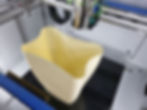Large Format Additive Manufacturing (3D Printing) vs. Traditional Manufacturing: Choosing the Right Method for Your Product
- compounddynamics
- Jan 7
- 4 min read
Updated: Jan 15
Manufacturing technology has evolved significantly in recent years, presenting product developers with an important choice between large format additive manufacturing (LFAM) and traditional manufacturing methods. Understanding the strengths and limitations of each approach is crucial for making the right decision for your specific product needs.

Understanding Additive Manufacturing vs. Traditional Manufacturing Technologies
Traditional manufacturing encompasses well-established processes like injection molding, casting, and machining. These methods have been refined over decades and became the backbone of modern industrial production. In contrast, LFAM is a newer technology that builds products layer by layer using materials like thermoplastics, composites, and even metals. Each approach brings its own set of advantages and considerations that must be carefully weighed against project requirements.
Cost Considerations Across Production Volumes
The economics of manufacturing often drive decision-making. Traditional manufacturing typically requires significant upfront investment in tooling and molds, which can range from $10,000 to $100,000 or more. However, once these initial costs are covered, the per-unit production cost decreases dramatically, often to just a few dollars per part. This cost structure makes traditional manufacturing particularly attractive for high-volume production runs where the initial investment can be amortized across many units.
LFAM presents a different cost structure. The initial investment focuses on the machine itself ($100,000 to $500,000) rather than product-specific tooling. Per-unit costs remain relatively constant, typically between $10 and $200 per kilogram of material, depending on the material choice and complexity. This makes LFAM particularly attractive for low to medium production volumes, typically under 1,000 units. The ability to begin production without tooling investment can significantly reduce barriers to entry for new products.
Time to Market Considerations
Traditional manufacturing requires significant lead time for tool design, fabrication, and testing. A typical injection mold might take 8-16 weeks to design and manufacture before the first production parts are available. Any design changes require additional time and cost for tool modifications, which can impact project timelines and budgets considerably.
LFAM can significantly compress development timelines. Without the need for tooling, products can move from design to production in days or weeks. Design iterations can be implemented immediately without additional tooling costs, making LFAM ideal for rapid product development and market testing. This agility can provide a significant competitive advantage in fast-moving markets where being first to market is crucial.
Design Freedom and Complexity
LFAM offers unprecedented design freedom. Complex geometries, internal channels, and integrated features that would be impossible or prohibitively expensive with traditional manufacturing become feasible. This capability enables part consolidation, reducing assembly requirements and potentially lowering overall production costs. The technology also allows for optimized internal structures for weight reduction and customization without additional tooling costs.
Sometimes creativity is needed to print parts that could not normally be 3D printed. This allows for an even wider range of possibilities in terms of shapes, although it may not be as simple as traditional methods.
Traditional manufacturing, while more constrained, offers advantages in surface finish, consistency, and material selection. It also typically provides better mechanical properties due to the nature of the manufacturing process. These benefits make it ideal for products requiring high consistency and established quality standards.
Material Selection and Properties
Traditional manufacturing supports a vast range of materials, from metals to plastics, with well-documented properties and established quality standards. These materials typically exhibit consistent, isotropic properties throughout the part, providing predictable performance in end-use applications.
LFAM materials, though growing in variety, currently offer a more focused selection. Common options include engineering thermoplastics like ABS, PLA, and PETG, as well as fiber-reinforced composites and specialized blends for specific applications. LFAM parts may exhibit anisotropic properties due to their layer-by-layer construction, with different strengths in different directions. This characteristic requires careful consideration during the design phase to ensure parts meet performance requirements.
Quality and Consistency
Traditional manufacturing, when properly set up, provides excellent part-to-part consistency and well-understood quality parameters. Surface finishes can be precisely controlled, and dimensional tolerances of ±0.1mm or better are achievable. This level of consistency is particularly important for high-volume production where parts must be interchangeable and meet strict quality standards.
LFAM technology produces parts with visible layer lines on surfaces and typically broader dimensional tolerances around ±0.5mm. While these characteristics might be acceptable or even advantageous in some applications, they require careful consideration during the design phase. The potential for warpage in large parts and variable mechanical properties between layers must also be accounted for in the design process.
Making the Right Choice
The decision of 3D printing vs traditional manufacturing should be based on a thorough analysis of your specific requirements. LFAM often proves ideal for products with production volumes under 1,000 units, complex geometries, rapid market entry requirements, or customization needs. Traditional manufacturing typically better serves high-volume production, applications requiring consistent material properties, superior surface finish, or tight tolerances.
Many successful manufacturers are adopting hybrid approaches, using LFAM for prototyping, production tooling, fixtures, and small production runs, while relying on traditional manufacturing for core high-volume production needs. This combined approach leverages the strengths of each technology while minimizing their respective limitations.
Compound Dynamics offers solutions for prototyping with our large format enclosed 3D printers, which can take a very large variety of materials. Get in touch with us to learn more.
Conclusion
The choice between Large Format Additive Manufacturing vs traditional manufacturing requires careful consideration of production volume, time to market, design complexity, material properties, quality standards, cost structure, and sustainability goals. By evaluating these factors against the strengths and limitations of each manufacturing method, you can make an informed decision that best serves your product's needs and business objectives. Remember that these technologies often complement rather than compete with each other, and the optimal solution might involve using both approaches at different stages of your product's lifecycle.







